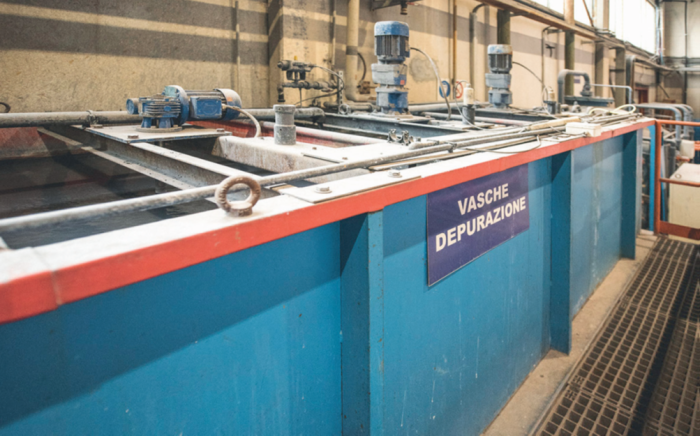25 January 2024
Waste water: an issue in the aluminum surface treatment industry turned into a challenge for improved environmental sustainability
Most companies performing aluminum surface pre-treatment operations use products containing high levels of fluorides, which call for special water purification treatments. However, especially today, in an era marked by pollution, it is necessary to embrace more and more sustainable practices – even in the aluminum industry.

From a legislative point of view, European regulations set maximum limits for the presence of fluorides in waste water. In Italy, for example, up to 6 ppm are allowed in surface discharge water and 12 ppm in waste water discharged into the sewerage system (subject to specific regional restrictions). This is why the treatment of process water is an indispensable production step in the aluminum industry. However, the traditional purification cycle based on an acidification phase followed by neutralization with lime often fails to achieve such low fluoride concentrations, even with prolonged cycle times. Sophisticated purification systems are therefore designed for this purpose, capable of removing specific pollutants.
If one of the challenges of today’s industry is to pursue productive growth while preserving our planet, the mission of Alit Technologies is to offer advanced technologies to reduce its customers’ environmental impact, generating a synergy that can lead to significant progress and improvement.
The Fluoridite series: high-quality products for waste water purification

Implementing clear strategies is key to achieving one’s goals. This is why Alit Technologies’ experts have devised an innovation that makes it easy to comply with the limits for the presence of fluorides in waste water. Their research work resulted in the creation of the Fluoridite series, an effective solution to tackle this challenge.
Fluoridite is a liquid product formulated to break down fluorides in waste water in the aluminum, steel, and glass industries. This agent can be added to the baths during the purification process, allowing fluorides to be removed from the treated water.
It has an exceptionally high efficiency and it can be easily used in already existing plants without the need to change their layout or waste water circulation system. After installation, it requires only a few adjustments to ensure that the discharged water’s fluoride concentration is below 2 ppm.
The effectiveness of Fluoridite in three actual industrial settings
When it comes to products intended for industrial use, it is always particularly interesting to analyze them in actual production contexts where their properties can be put to the test.
The three case studies collected below not only demonstrate the effectiveness of Fluoridite in keeping fluoride levels below regulatory limits for both sewage and surface discharge water, but also offer some examples of concrete applications that may be useful in understanding how this product works.
The initial problem
As already pointed out, the basic issue reported by companies is the need not to exceed the legal limits for the concentration of fluorides in waste water. This also results in a production issue since, in order to comply with these regulations, manufacturers can be forced to reduce the use of products containing hydrofluoric acid and its derivatives and, consequently, limit their production flow.
Success cases: contexts and solutions
The first success case we would like to present concerns a company headquartered in northern Italy, which coats about 15 tons per day of aluminum every 8-hour shift. It now uses Fluoridite for its purification process. The production line includes alkaline, acid, and non-chromic passivation pre-treatment stages and the purification plant handles 5 m3/h of cleaning water. Fluoridite’s dosage is about 800 ppm in the first tank, followed by neutralization with lime to pH 8 and flocculation. Thanks to the use of Fluoridite, the clarified water always has fluoride values below 9 ppm, i.e. below the legal limit of 12 ppm for discharge into the sewage system.
The protagonist of the second success case is another Italian company specializing in the coating of aluminum profiles and sheets, which processes around 60 tons per day in three 8-hour shifts. The company has two surface pre-treatment lines, one performing acid degreasing/deoxidation and non-chromic passivation and the other alkaline degreasing, acid deoxidation, and non-chromic passivation. The purification line collects water from both plants (6 m3/h in total). To comply with the 6 ppm limit for surface discharge water, the dosage of Fluoridite here is approximately 3500 ppm.
The third case study concerns a company located in central Italy, specializing in the coating and decoration of aluminum profiles. It processes around 50-55 tons per day in three shifts with a treatment operation involving several stages. Waste water is conveyed to a purification plant using Fluoridite. The limit for fluorides, again equal to 6 ppm, is successfully achieved through the accurate dosing of Fluoridite in the purification tank, which has reduced the fluoride concentration in the discharged water from around 30 ppm to less than 4 ppm, thus safely meeting the legal limit.
The advantages of Fluoridite
The use of Fluoridite brings several benefits, including as follows:
- Ease of dosage;
- Compliance with legal limits;
- Quick supply;
- Dedicated technical support.
In summary, Fluoridite is a clear example of Alit Technologies’ constant dedication to research and development. It is the result of this company’s commitment to offer state-of-the-art solutions for a more sustainable and compliant industrial future.
And if it is true that collaboration in the industrial sector is of paramount importance in moving towards a greener future, Alit Technologies urges all companies dealing with the presence of fluorides in waste water to contact its specialized staff to identify the best solution to their specific needs.
Together, we can do more!



